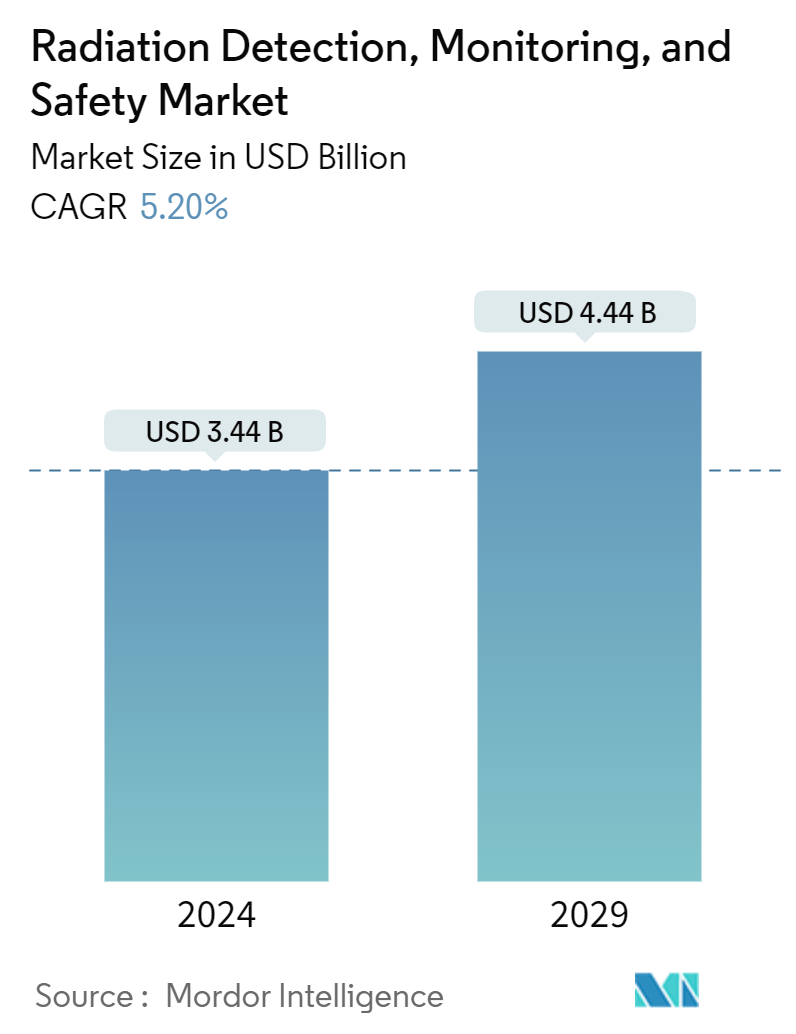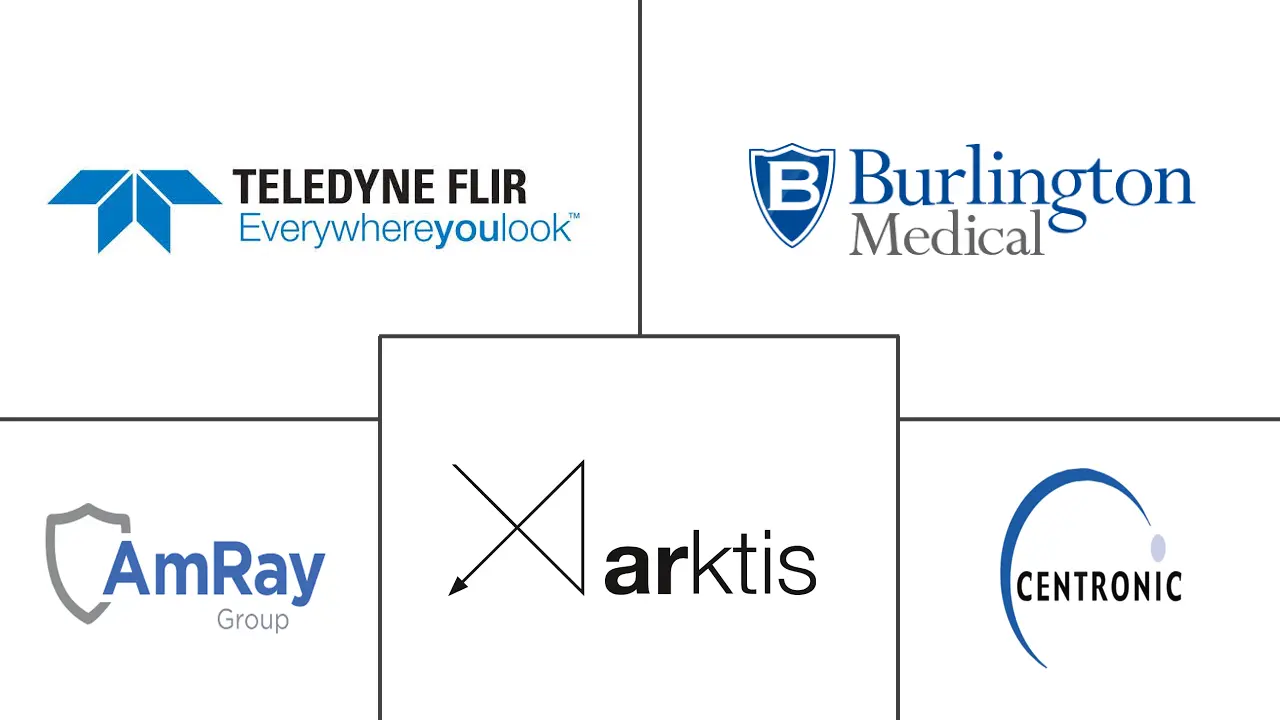
| Study Period | 2019 - 2029 |
| Market Size (2024) | USD 3.44 Billion |
| Market Size (2029) | USD 4.44 Billion |
| CAGR (2024 - 2029) | 5.20 % |
| Fastest Growing Market | Asia Pacific |
| Largest Market | North America |
| Market Concentration | Low |
Major Players
*Disclaimer: Major Players sorted in no particular order |
Radiation Detection, Monitoring, And Safety Market Analysis
The Radiation Detection, Monitoring, And Safety Market size is estimated at USD 3.44 billion in 2024, and is expected to reach USD 4.44 billion by 2029, growing at a CAGR of 5.20% during the forecast period (2024-2029).
The increased stability of manufacturing industries will likely drive the market's growth during the forecast period. Using radiography testing in the manufacturing industry to test the quality of manufactured goods and inspect flaws is also likely to fuel the market.
- According to the World Nuclear Association Plans for New Reactors Worldwide, nuclear power capacity increased steadily, with about 50 power reactors under construction around the world. Most of the reactors are planned in Asia (in China, India, and South Korea, among others), with new units in Russia and the United Arab Emirates, while the existing capacity is being created by plant upgrading.
- According to the World Energy Outlook (WEO) report, its Stated Policies Scenario' witnesses installed nuclear capacity growth of over 15% from 2019 to 2040, about 480 GWe. The scenario predicts a total generating capacity of 13,418 GWe by 2040, concentrated heavily in Asia, particularly India and China. The contribution of nuclear to global power generation is expected to reach about 8.5% by 2040.
- Plant lifetime extension programs maintain capacity, particularly in the United States. Almost all the power reactors in the United States can potentially be licensed to operate for 60 years, with owners undertaking significant capital works to upgrade them at around 30-40 years. The license renewal process typically costs USD 16-25 million, and the procedures for such renewals, with public meetings and complete safety reviews, are exhaustive.
- In March 2000, the Nuclear Regulatory Commission (NRC) renewed the two-unit Calvert Cliffs nuclear power plant's operating licenses for an additional 20 years. The NRC is considering applications for extending operating licenses beyond 60 out to 80 years with its subsequent license renewal (SLR) program. During the second wave of the COVID-19 pandemic, reactors approved for 80-year licenses were Turkey Point 3&4, Peach Bottom 2&3, and Surry 1&2 in the United States. Therefore, plant lifetime extensions by various countries are expected to boost the market's growth during the forecast period.
- The strict regulations provided by regulatory bodies are expected to affect product approvals and compliances and private body-led monitoring, thereby hampering the market's growth.
- According to the National Bureau of Statistics of China, in 2023, China's industrial production increased by about 4.6% compared to the previous year. According to the Department for Promotion of Industry and Internal Trade (India), the manufacturing industry appears to be a fast-growing sector owing to the rapidly growing population in India. Factors like these are expected to create more opportunities in the market in the coming years.
Radiation Detection, Monitoring, And Safety Industry Segmentation
The market is defined by the revenue generated from the sale of radiation detection, monitoring, and safety products offered by different market players for a diverse range of end-user industries.
The radiation detection monitoring and safety market is segmented by product type (detection & monitoring, safety), end-user industry (medical & healthcare, industrial, homeland security & defense, energy & power, and other end users), and geography (North America, Europe, Asia-Pacific, Latin America, and Middle East and Africa). The market sizes and forecasts are provided in terms of value (USD) for all the above segments.
| Detection and Monitoring |
| Safety |
| Medical and Healthcare |
| Industrial |
| Homeland Security and Defense |
| Energy and Power |
| Other End-user Industries |
| North America |
| Europe |
| Asia |
| Australia and New Zealand |
| Latin America |
| Middle East and Africa |
Radiation Detection, Monitoring, And Safety Market Size Summary
The radiation detection, monitoring, and safety market is poised for significant growth over the forecast period, driven by increased stability in manufacturing industries and the rising adoption of radiography testing to ensure product quality. The expansion of nuclear power capacity, particularly in Asia, is a key factor contributing to market growth, as new reactors are being constructed and existing ones are being upgraded. This trend is supported by plant lifetime extension programs, especially in the United States, where reactors are being licensed to operate for extended periods. However, stringent regulations from regulatory bodies may pose challenges to market expansion by affecting product approvals and compliance processes. The manufacturing sector's demand for non-destructive testing techniques further bolsters the market, alongside the healthcare industry's growing need for radiation detection and monitoring equipment due to increased cancer diagnoses and treatment investments.
The Asia-Pacific region is expected to experience substantial growth in the radiation detection, monitoring, and safety market, driven by the region's focus on nuclear power for energy generation and stringent safety regulations. The rapidly advancing healthcare infrastructure in countries like India and China also contributes to this growth, as investments in modernizing medical facilities and incorporating advanced diagnostic technologies rise. The market is characterized by fragmentation, with companies and startups innovating to enhance their technological offerings and market presence. Strategic partnerships, such as the collaboration between Thermo Fisher Scientific and Radiation Detection Company, highlight the industry's focus on integrating digital technologies for improved radiation monitoring. Additionally, advancements in radiation detection equipment, such as the US military's adoption of modular systems, underscore the ongoing technological evolution within the market.
Radiation Detection, Monitoring, And Safety Market Size - Table of Contents
1. MARKET DYNAMICS
- 1.1 Market Overview
- 1.2 Industry Attractiveness - Porter's Five Forces Analysis
- 1.3 Industry Value Chain Analysis
- 1.4 Impact of COVID-19 Aftereffects and Other Macroeconomic Factors on the Market
- 1.5 Technology Snapshot
-
1.6 Market Drivers
- 1.6.1 Increasing Incidence of Cancer and Other Chronic Diseases
- 1.6.2 Growing Use of Drones for Radiation Monitoring
-
1.7 Market Restraints
- 1.7.1 Stringent Government Regulations
- 1.7.2 Lack of Skilled Radiation Professionals
2. MARKET SEGMENTATION
-
2.1 By Product Type
- 2.1.1 Detection and Monitoring
- 2.1.2 Safety
-
2.2 By End-user Industry
- 2.2.1 Medical and Healthcare
- 2.2.2 Industrial
- 2.2.3 Homeland Security and Defense
- 2.2.4 Energy and Power
- 2.2.5 Other End-user Industries
-
2.3 By Geography***
- 2.3.1 North America
- 2.3.2 Europe
- 2.3.3 Asia
- 2.3.4 Australia and New Zealand
- 2.3.5 Latin America
- 2.3.6 Middle East and Africa
Radiation Detection Monitoring and Safety Market Research FAQs
How big is the Radiation Detection, Monitoring, And Safety Market?
The Radiation Detection, Monitoring, And Safety Market size is expected to reach USD 3.62 billion in 2025 and grow at a CAGR of 5.20% to reach USD 4.66 billion by 2030.
What is the current Radiation Detection, Monitoring, And Safety Market size?
In 2025, the Radiation Detection, Monitoring, And Safety Market size is expected to reach USD 3.62 billion.


